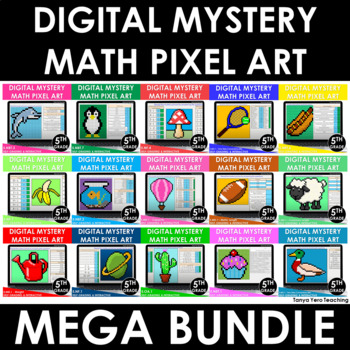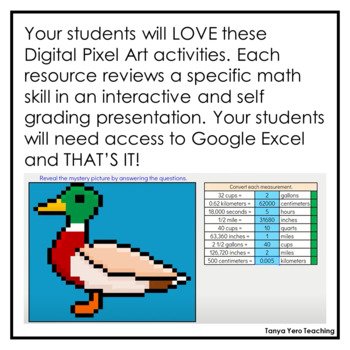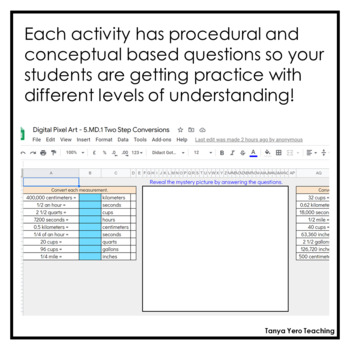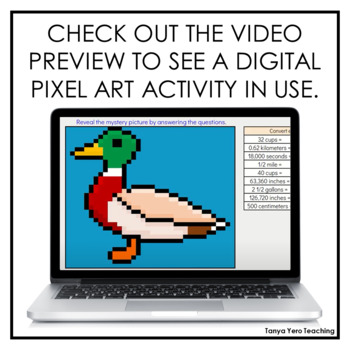5th Grade Math Review Math Centers Digital Math Pixel Art YEARLONG Bundle
- Zip
- Google Apps™

What educators are saying
Description
Digital Math Pixel Art Activities are ready to go activities for Google Excel that review a specific math skill. As your students correctly answer various questions (both procedural and conceptual based) a mystery picture will start to reveal. This activity is self-grading and interactive for students!
29 READY TO GO RESOURCES--YOUR MATH CENTERS FOR THE YEAR ARE HERE!
CHECK OUT THE VIDEO PREVIEW TO SEE THIS ACTIVITY IN ACTION!
Standards & Topics Covered
Numbers and Operations In Base Ten
➥ 5.NB.1 - Place value concepts
➥ 5.NBT.2 – Multiplying and dividing by powers of 10
➥ 5.NBT.3 - Number Form, Word Form, Expanded Form, and Comparing of decimals
➥ 5.NBT.4 – Rounding decimals
➥ 5.NBT.5 – Multiplying multi-digit numbers
➥ 5.NBT.6 - Dividing whole numbers
➥ 5.NBT.7 – Adding, subtracting, multiplying, and dividing decimals
Operations in Algebraic Thinking
➥ 5.OA.1 - Order of operations
➥ 5.OA.2 - Expressions
Geometry
➥ 5.G.1 - Coordinate grids
➥ 5.G.2 - solving word problems with coordinate grids
➥ 5.G.3 - understanding shapes and their attributes
➥ 5.G.4 - classifying shapes
Fractions
➥ 5.NF.1 - Adding and subtracting fractions with unlike denominators
➥ 5.NF.2 - Adding and subtracting fraction word problems
➥ 5.NF.3 - Interpreting fractions as division
➥ 5.NF.4 - Multiplying fractions
➥ 5.NF.5 - Multiplication as scaling
➥ 5.NF.6 - Multiplying and dividing fraction word problems
➥ 5.NF.7 - Dividing fractions
Measurement and Data
➥ 5.MD.1 - converting units of measure that include
- Customary units of length
- Metric units of length
- Weight
- Capacity
- Measurement mix of one step conversions
- Measurement mix of two step conversions
➥ 5.MD.2 - line plots
➥ 5.MD.3 - understanding volume
➥ 5.MD.4 - measuring volume
➥ 5.MD.5 - additive volume
Benefits of this resource:
- Whether you are in a traditional classroom setting, completing distancing learning, or a mix of both you’ll have key resources to review math standards
- NO PREP
- Academically engaging
- Auto-graded
- Procedural and conceptual based questions are included
- Interactive!!
Who should purchase this resource?
- Teachers looking for resources that can be used in the classroom and for distance learning
- Teachers looking for resources that review BOTH procedural and conceptual understanding of math content
- Teachers looking for digital activities for math review, math test prep, or math practice
- Teachers looking for READY TO GO digital activities





